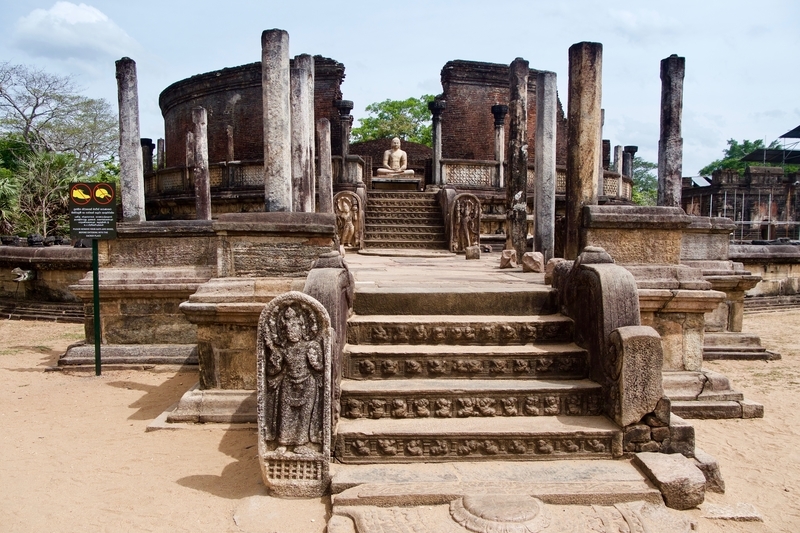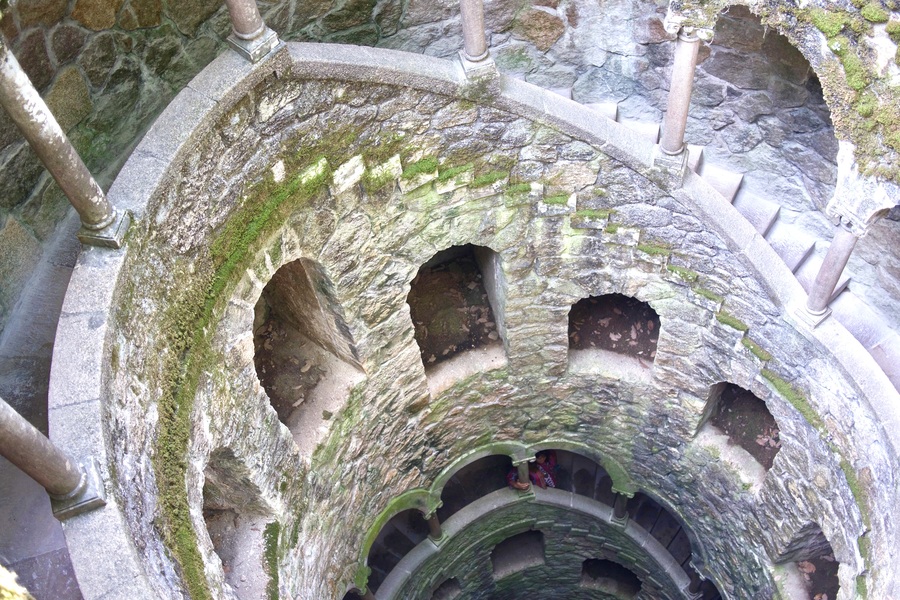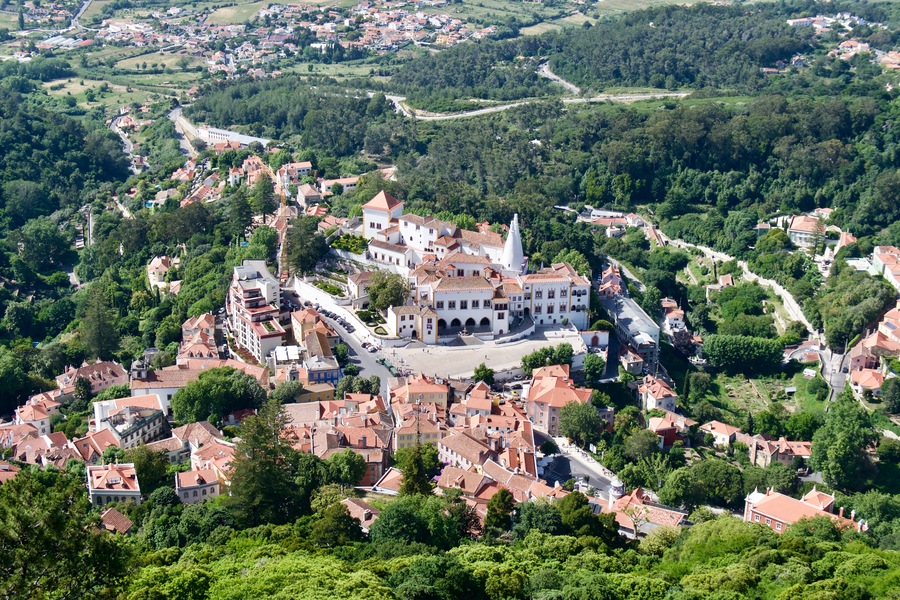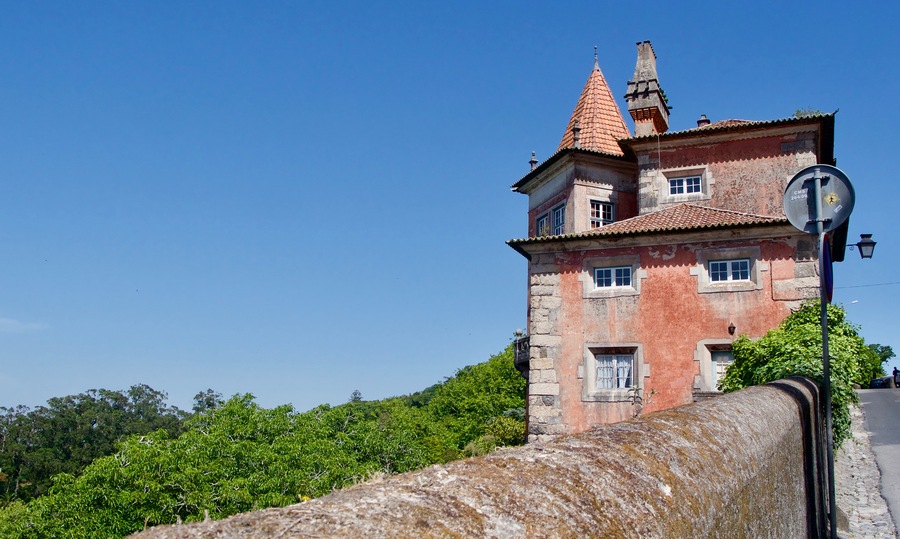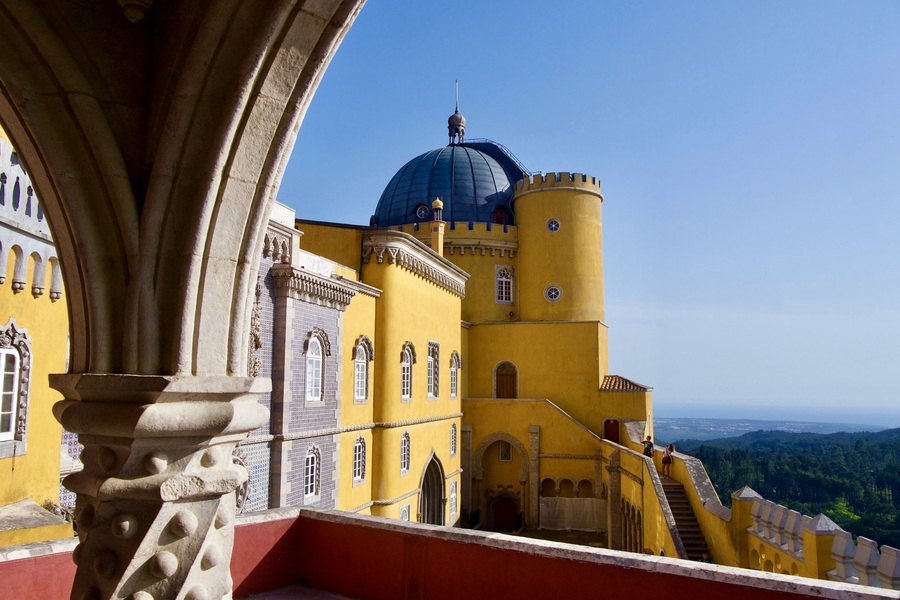
Sintra Day Trip: Visiting Portugal’s Fairytale City
With its sea of rolling green hills, its whimsical palaces, and its its pastel houses, UNESCO-recognized Sintra is one of Portugal’s most enchanting gems.
The photogenic city entices visitors with its verdant setting and dreamy charm. Once referred to as a “glorious Eden” by Lord Byron, Sintra has become a popular day trip destination from Lisbon.
Home to some of the most beautiful castles and palaces in Europe, Sintra is chock-a-block full of places to visit. These colorful estates and crumbling fortifications lie hidden within the city’s forested hills—resembling the backdrop to a fairy tale.
DAY TRIP TO THE SINTRA PALACES
Sintra is located around 40 minutes northwest of Lisbon and 3 hours south of Porto, within the stunning Parque Natural Sintra-Cascais. Once the preferred summer destination for royalty, the picturesque hilltop town now attracts throngs of day-tripping tourists.
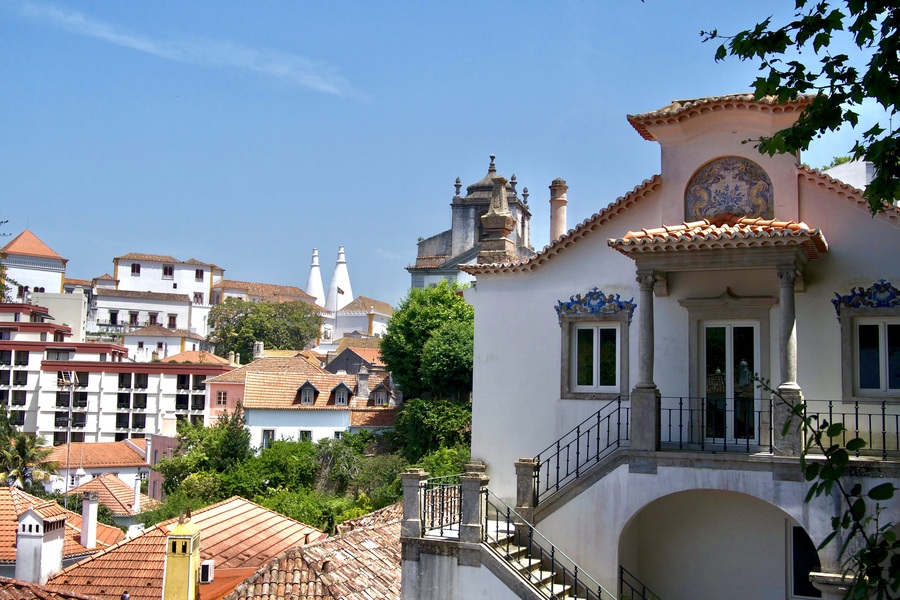
In my short whirlwind visit to Sintra, I did not have time to experience everything there is to do in the city.
But still, I was still able to get a sampling of the regal palaces that make it such an enticing place to visit.
-
THE PENA PALACE IN SINTRA
The Pena Palace boasts a wacky amalgam of architectural styles. It is considered to be the greatest expression of 19th-century romanticism in Portugal. For many, it is the top thing to see in Sintra.
The palace was built in 1854, at the request of King Ferdinand II. With its construction, architect Wilhelm Ludwig von Eschwege transformed a ruined monastery into an enchanting castle that includes elements of Gothic, Moorish and Renaissance design.
The Disney-like castle is an indulgent mix of open terraces, decorative archways and ornamental towers. Its exterior erupts in vivid shades of red, yellow and purple.
Inside, its eclectic rooms are equally unusual.
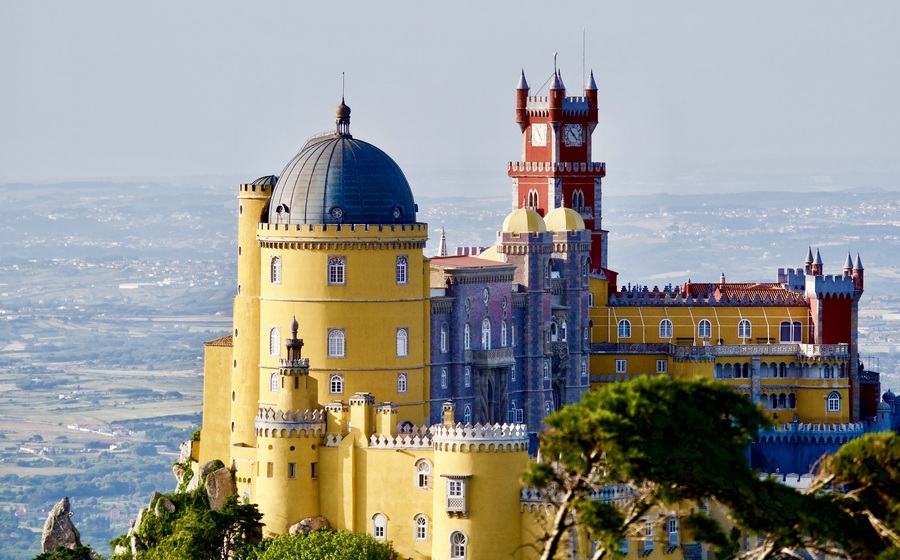
The Pena Park is a vast forested area that completely surrounds the colorful palace. It sprawls out over more than 200 hectares—concealing statues, viewpoints, fountains, and the Chalet de Condesa d’Edla.
For fantastic views of the Pena Palace, hike to the top of Cruz Alta.
Entrance fees for the castle grounds cost €7.50. The tickets include access to the Pena Palace’s terraces and its resplendent gardens.
For a combination ticket that encompasses the palace’s interior and its grounds, the entrance fee is €14
-
THE CASTLE OF THE MOORS
Soaring more than 400 meters above the Atlantic, the mist-shrouded Moorish Castle is among the most prominent Sintra landmarks.
Built during the 8th and 9th centuries, the Castle of the Moors stands atop one of the highest hills in the area. Its beautifully-situated ruins wind over two mountain ridges and provide stunning birds-eye panoramas of the city’s downtown,
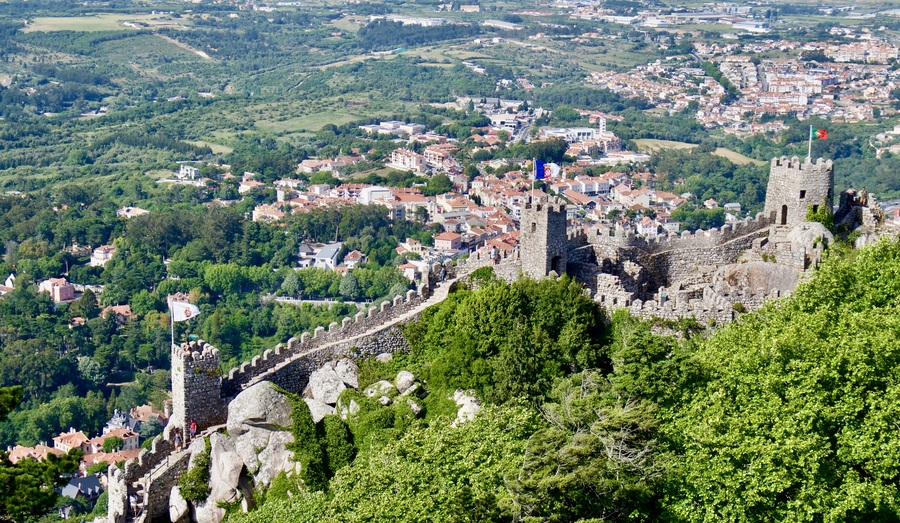
Reaching the Castle of the Moors from downtown Sintra requires following Rua Marechal Saldanha for 2km.
Entrance to the castle costs €8.
-
THE QUINTA DA REGALEIRA
The Quinta da Regaleira—a decorative 20th century palace situated near the town’s center—is another of Sintra’s iconic palaces.
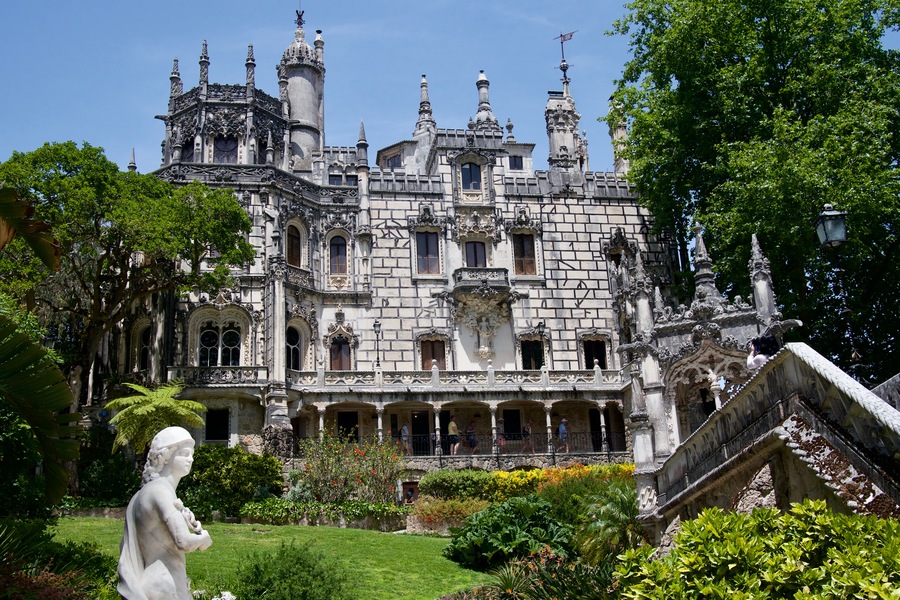
Gothic pinnacles, gargoyles and towers adorn the structure’s ornate façade. Its architecture is believed to be laden with symbols related to alchemy, Masonry and the Knights Templar.
The Regaleira Palace grounds include lavish buildings and a luxurious park. They feature grottos, lakes, fountains and underground passages.
The Quinta da Regaleira’s most notable landmarks are a pair of wells that spiral deep underground. Resembling inverted towers, these wells were never used to collect water.
Rather, theories suggest that they were once intended for ceremonial purposes, including Tarot rituals.
-
THE SINTRA NATIONAL PALACE
The Sintra National Palace, located in the center of town, is also sometimes known as Palácio da Vila. The white Medieval castle dates back to the 9th century. Its architecture is a mixture of styles, including elements of Medieval, Gothic, Manualine and Renaissance design.
The central palace became the official home of King João in the 14th century and was used by the Portuguese royal family until the end of monarchy in 1910.
Though I enjoyed photographing the palace’s exterior, I didn’t visit the interior of the National Palace.
If you’re looking to go inside, you can visit between 9:30am and 7pm. Admission costs €10.
-
MONSERRATE PALACE
The Montserrate Palace (not to be confused with the Montserrat Monastery near Barcelona) lies at the center of a lush, 30-hectare park. Its whimsical Moorish-Gothic-Indian structure dates back to the mid-19th century and was the romantic vision of English millionaire Sir Francis Cook.
The palace lies 3.5 km west of downtown. Its gardens teem with exotic plants and foliage.
I didn’t get the opportunity to visit the Monserrate Palace during my trip to Sintra.
However, if you have the extra time, I’m told its worth including in your itinerary.
OTHER THINGS TO DO IN THE SINTRA-CASCAIS NATIONAL PARK
If you’re traveling to Sintra as a day trip, chances are you’ll want to spend your time hopping from palace to palace.
After all, the lavish residences are the reason the town has gained notoriety as one of Portugal’s most alluring destinations.
But there are other things to do in Sintra, palace-hopping aside.
-
VISIT CABO DA ROCA
Cabo da Roca’s surroundings reminded me of a mixture between the idyllic coastline of southern Portugal’s Algarve and Ireland’s towering Cliffs of Moher.
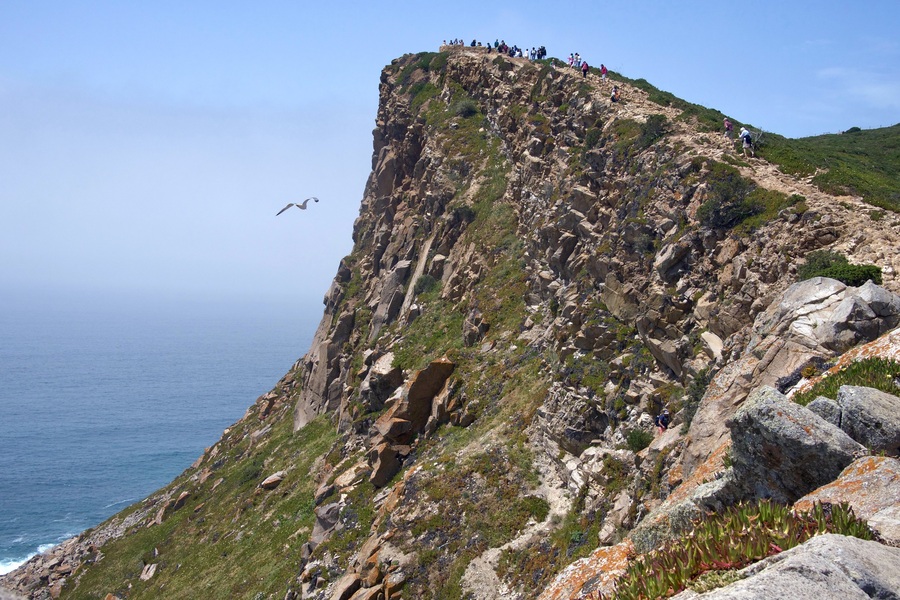
With flower-speckled hillsides, windswept beaches and jagged rock formations that look as though they are trying to pierce through layers of fog, the landscape at Cabo da Roca is at once dramatic, photogenic and uncompromisingly wild.
-
HIKE TO PRAIA DA URSA
From Cabo da Roca, a beautiful trail winds its way down to Praia da Ursa.
As it makes its way toward the secluded sandy beach, the 2.4 mile trail showcases some of western Portugal’s most wild coastal scenery
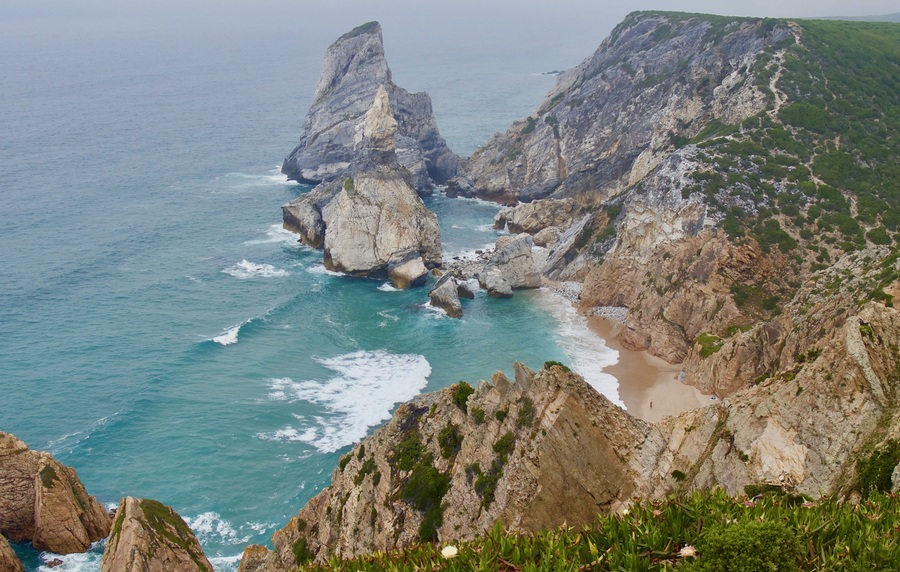
Praia da Ursa is a lovely photogenic beach, but it is not a safe swimming destination due to rough swells.
GETTING TO SINTRA FROM LISBON
Thanks to its easy access to the Portuguese capital, Sintra is one of the most popular day trip destinations from Lisbon.
The best way to get to Sintra from Lisbon is by train. Unless you’re touring Portugal by car, you’ll probably want to avoid driving to Sintra, as parking can be incredibly difficult to come across.
You can catch a train to Sintra from the central Rossio Train Station in Baixa. Trains depart roughly every half hour. The journey takes roughly 40 minutes.
Tickets between Lisbon and Sintra cost between €2-3 each way. There’s no need to book in advance.
WHERE TO STAY IN SINTRA
Full disclosure: I didn’t visit Sintra as a day trip.
Though the fairytale city is an incredibly popular day trip destination, I chose to stay overnight instead.
Spending the night in Sintra allowed me the luxury of visiting the town’s highlights during off-peak hours—both before busloads of day-trippers ascended on the town, and after most tour groups had begun making their way back to Lisbon.
For budget-conscious travelers intent on staying overnight, the Moon Hill Hostel advertises a central location and cheap dorm rooms.
Mid-range options include the Villa Estefania and the Sintra Boutique Hotel.
And if you’re looking for a top-end choice, the Sintra Marmoris Palace is one of the most beautiful places to stay in Sintra. It boasts character-filled rooms, a heated pool, and views over the Moorish Castle.
GETTING AROUND SINTRA
Due to the concentration of its attractions, Sintra is relatively walkable. I used my own two feet to get from palace to palace and only relied on public transportation when venturing outside of the city towards Cabo da Roca.
If you’re planning on walking, however, I suggest you map out your day trip itinerary strategically, beginning with the Pena Palace and Castle of the Moors. Sintra is quite hilly. If you plan out your route haphazardly, you might end up exerting all your energy trying to navigate its steep slopes.
Aside from walking, the most affordable way to get around is by taking the tourist buses that run between Sintra’s most popular attractions. These buses are the 434 and 435.
Sintra’s surroundings can be easily explored using public transport. Buses for the coast depart from Sintra’s train station and meander through small towns and villages, toward Cabo da Roca.
****
In Sintra, glittering palaces and resplendent gardens lie folded into the hills of the Sintra-Cascais National Park.
The small city is full of whimsical style and opulent flair. A playground for the wealthy throughout the 19th century, it is now a thriving tourist destination that welcomes millions of visitors annually.
In peak season, crowds flock to Sintra’s palaces.
But you shouldn’t let the hoards of day-tripping tourists deter you.
For—like a page torn from a fairytale—the idiosyncratic Portuguese city is nothing short of magical.
